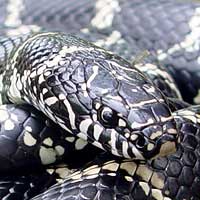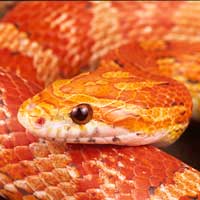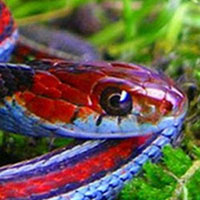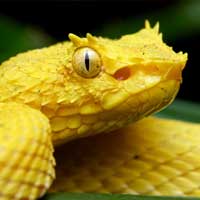Eastern Kingsnake: Everything You Need to Know About This Remarkable Snake
The scientific name of the Eastern Kingsnake is Lampropeltis getula. It belongs to the Colubridae family, which is the largest family of snakes and includes many non-venomous and mildly venomous species.
Scientific Name: Lampropeltis getula
Snake Family: Colubridae

Introduction to the Eastern Kingsnake
The Eastern Kingsnake (Lampropeltis getula) is a strikingly patterned, non-venomous snake native to the eastern United States. Known for its adaptability and bold black and white chain-like pattern, this snake is a vital predator in its ecosystem. Its calm demeanor and hardiness make it a popular pet for reptile enthusiasts.
Where Does the Eastern Kingsnake Live?
The Eastern Kingsnake is highly adaptable, thriving in a variety of environments across its range, from the southeastern United States to parts of the Midwest. Its habitat preferences reflect its versatility as a predator.
Preferred Habitat Features:
- Forests and woodlands
- Wetlands and swamps
- Grasslands and meadows
- Suburban areas near water sources
| Region | Habitat Type | Key Features |
|---|---|---|
| Southeastern USA | Forests and wetlands | Shaded areas, abundant prey |
| Mid-Atlantic | Grasslands | Open fields, small rodents |
| Florida | Swamps | Humid climate, dense vegetation |
What Does the Eastern Kingsnake Eat?
The Eastern Kingsnake is a carnivorous predator with a diverse diet. Its ability to prey on venomous snakes adds to its reputation as a valuable part of the ecosystem.
Common Diet:
- Rodents such as mice and rats
- Lizards
- Birds and their eggs
- Venomous snakes, including rattlesnakes
In captivity, feeding frozen-thawed rodents is recommended for convenience and safety. Juveniles should be fed every 5-7 days, while adults require feeding every 10-14 days.
Behavior and Temperament of the Eastern Kingsnake
Known for its calm demeanor, the Eastern Kingsnake is a popular pet choice. However, it may exhibit defensive behaviors when threatened, such as coiling and vibrating its tail.
Key Behavioral Traits:
- Non-aggressive and docile
- Active during the day and twilight hours
- Displays defensive coiling and hissing when startled
- Skilled hunters with a strong constricting ability
With consistent, gentle handling, these snakes quickly become comfortable around humans, making them ideal pets for beginners and experienced keepers alike.
Health and Lifespan of the Eastern Kingsnake
The Eastern Kingsnake is a hardy species with a lifespan of 15-20 years when properly cared for. Regular monitoring of its health and habitat is essential for longevity.
Common Health Concerns:
- Respiratory infections caused by improper humidity
- Shedding issues due to low humidity levels
- Parasites, especially in wild-caught specimens
Maintain a temperature gradient of 75-85°F, provide fresh water for hydration and soaking, and ensure a clean environment to prevent health issues. Regular check-ups with a reptile veterinarian are recommended.
Reproductive Traits of the Eastern Kingsnake
The Eastern Kingsnake is oviparous, laying eggs after mating. Reproduction typically occurs in the spring, with females laying eggs in early summer.
Reproductive Details:
- Mating season: Spring
- Clutch size: 6-15 eggs
- Incubation period: 50-70 days
- Hatchlings are independent at birth
In captivity, providing a nesting area and maintaining proper incubation temperatures (82-85°F) are crucial for successful breeding.
How to Handle and Care for the Eastern Kingsnake
Caring for an Eastern Kingsnake involves creating a habitat that mimics its natural environment and providing consistent, gentle handling.
Handling and Care Tips:
- Handle regularly to build trust and reduce stress
- Provide an enclosure with hiding spots and climbing structures
- Maintain proper humidity and temperature levels
- Offer a varied diet to meet nutritional needs
With proper care, the Eastern Kingsnake can thrive in captivity, offering years of fascination and companionship to its keeper.
Other Snakes In This Species
 Albino California Kingsnake
Albino California Kingsnake Arizona Mountain Kingsnake
Arizona Mountain Kingsnake Black Kingsnake
Black Kingsnake Brooks Kingsnake
Brooks Kingsnake California Kingsnake
California Kingsnake Desert Kingsnake
Desert Kingsnake Dot-Dash California Kingsnake
Dot-Dash California Kingsnake Durango Mountain Kingsnake
Durango Mountain Kingsnake Eastern Kingsnake
Eastern Kingsnake Florida Kingsnake
Florida Kingsnake Florida Mole Kingsnake
Florida Mole Kingsnake Goins Kingsnake
Goins Kingsnake Gray Banded Kingsnake
Gray Banded Kingsnake Mexican Black Kingsnake
Mexican Black Kingsnake Mole Kingsnake
Mole Kingsnake Prairie Kingsnake
Prairie Kingsnake Ruthvens Kingsnake
Ruthvens Kingsnake Scarlet Kingsnake
Scarlet Kingsnake Speckled Kingsnake
Speckled Kingsnake Utah Mountain Kingsnake
Utah Mountain Kingsnake Variable Kingsnake
Variable Kingsnake








